KP Brehmer:
Welt im Kopf [World in Mind]
In collaboration with Petzel Gallery, New York
Curated by Elisa R. Linn and Lennart Wolff
Opening Thursday March 2, 6-8PM
March 1 - April 1, 2023
— Press Release
— Checklist
— Mousse
— The Brookyn Rail
All Images
Close

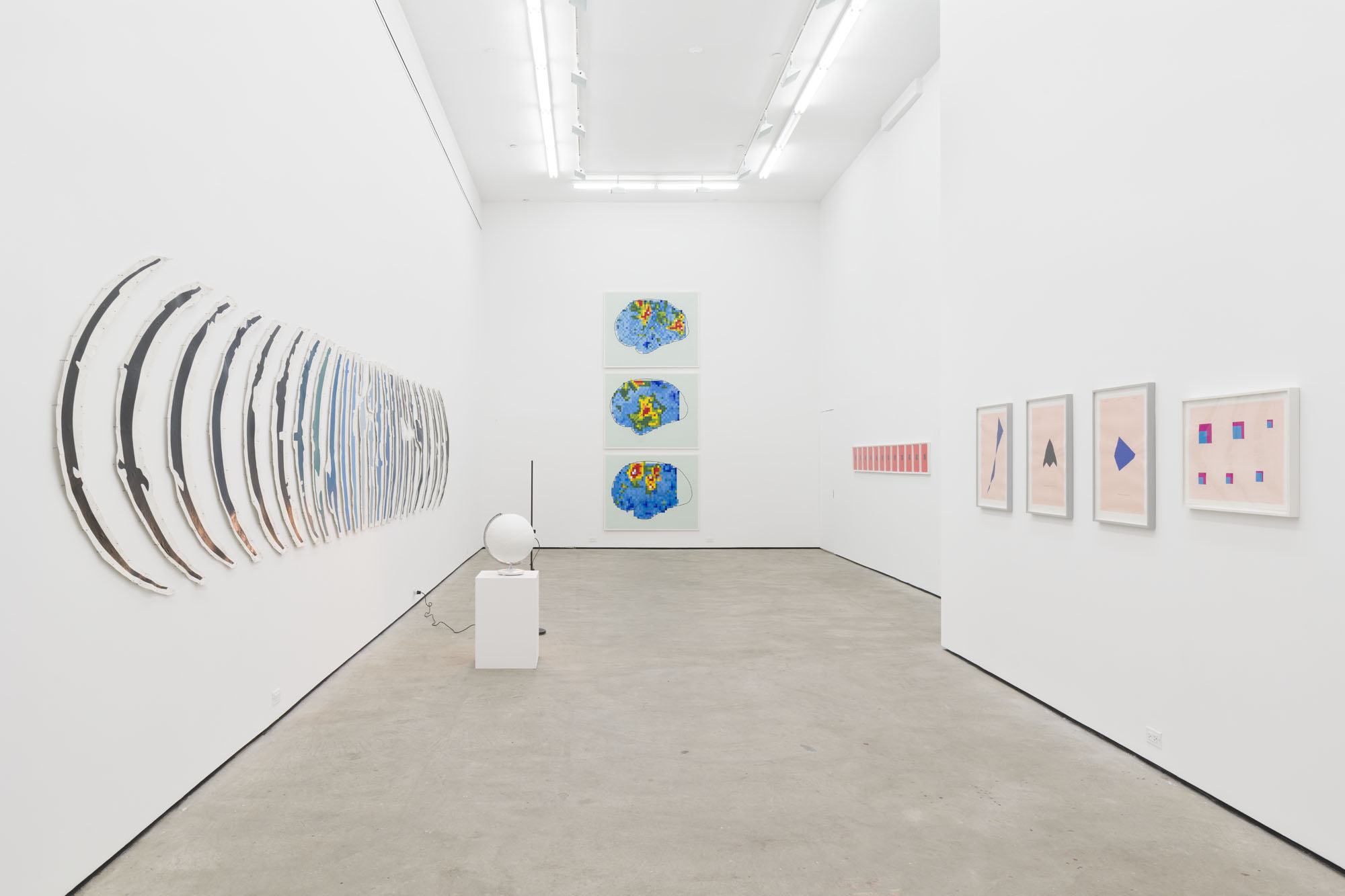
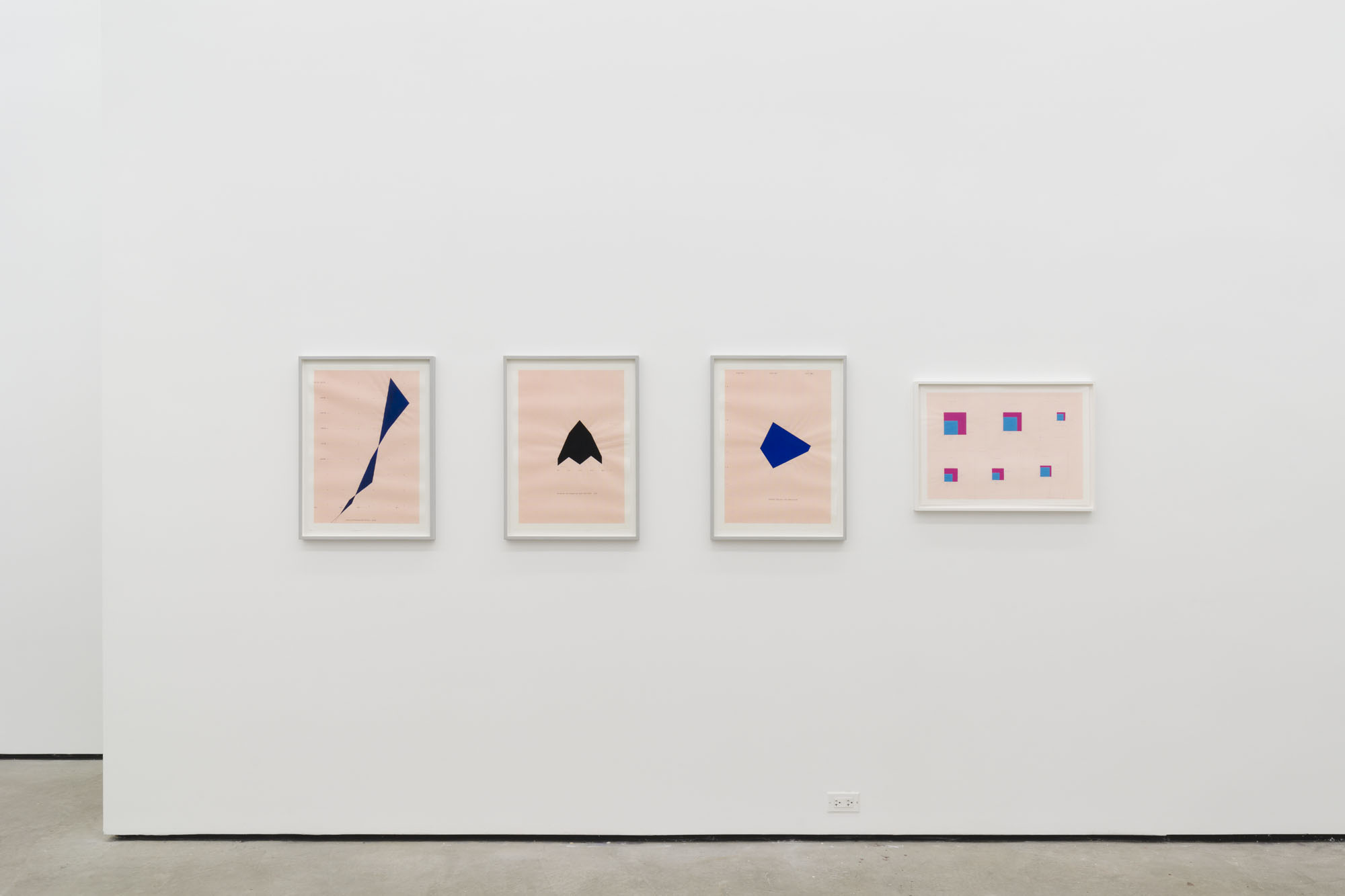
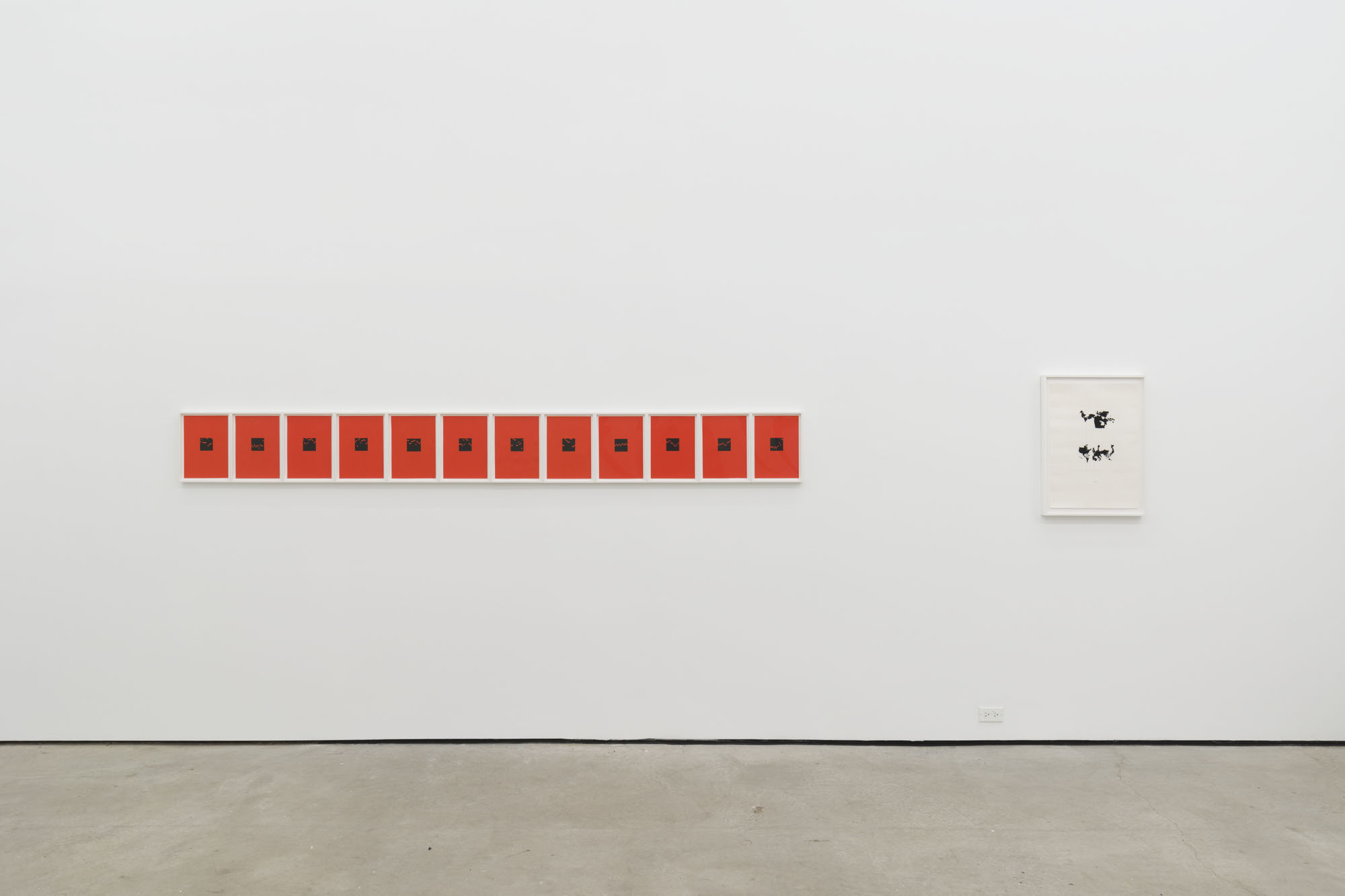
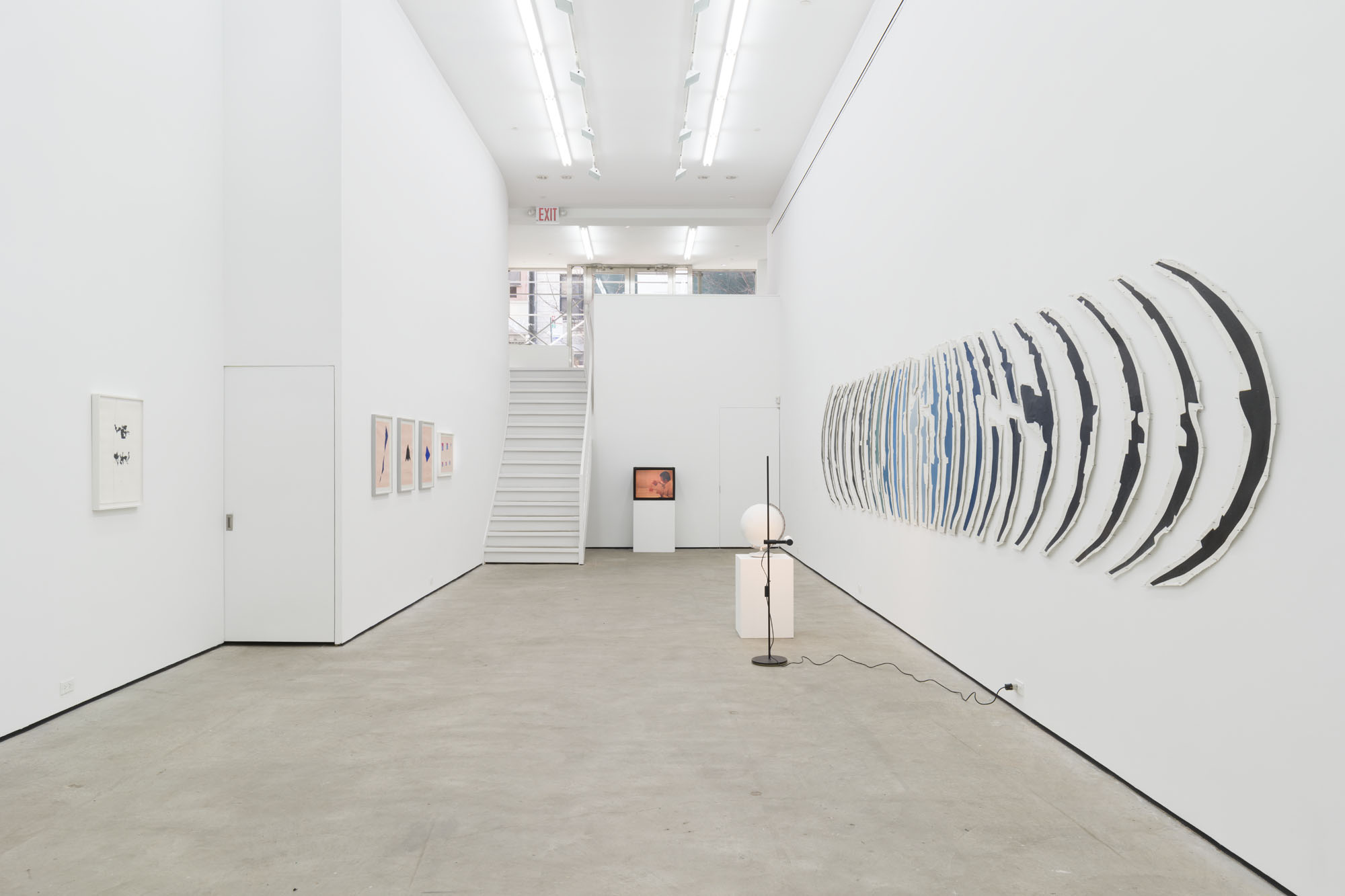
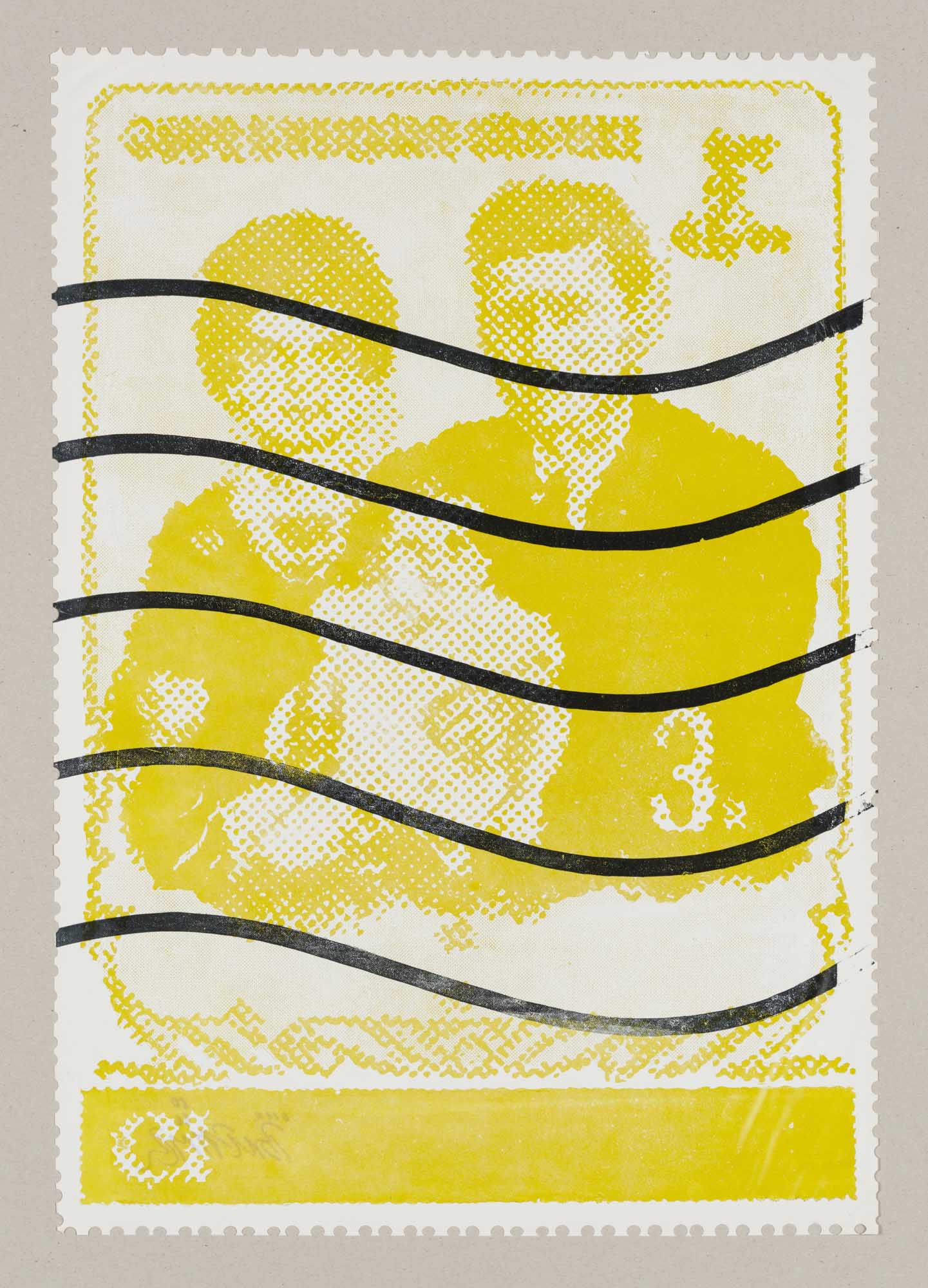
KP Brehmer
Kennedy (B 011k), 1966
Cliché print on plastic
Silver gelatin print on glossy baryta paper board
13 ⅜ × 21 ⅝ inches (33.97 × 54.93 cm)
Edition of 50 (René Block, B 73)
In the 1960s, Brehmer had been concerned with the possibilities of democratizing the consumption of art by making cliché prints that could be reproduced authentically and hence be sold in highly-affordable unlimited editions. When a lack of a popular market prompted Brehmer to “retreat to the play with the art collectors,” he started appropriating stamps. At the time, these “business cards of the state” (Walter Benjamin) or Symbolwerte [Symbolic values], as Brehmer would call them, were employed in the Cold War’s ideological competition that also played out in the so-called Deutsch-Deutscher Postkrieg [German-German postal war]. Here, stamps were issued to reinforce a collective national image and steer the self-perception of its subjects, to which Brehmer responded by exercising “ideological kleptomania” (Georg Jappe) through appropriating, collaging, and manipulating. With the stamps series, Brehmer developed what he would describe as multiple coded images: Ones that invite the viewer to consider not only motif and style of rendering but also color, printing technique, and choice of support material and edition. Most of the works in this series were made by Brehmer himself on his printing press, with perforations and faux postmarks added by hand. Here, he differentiated the stamps into museum, collector, or popular editions, producing single prints and series compiled into Auswahlbeutel [Assortments] or arranged as Albumbogen [Album sheet]. In 1967, he first exhibited his stamps at Galerie René Block in the Western part of the then-divided Berlin.
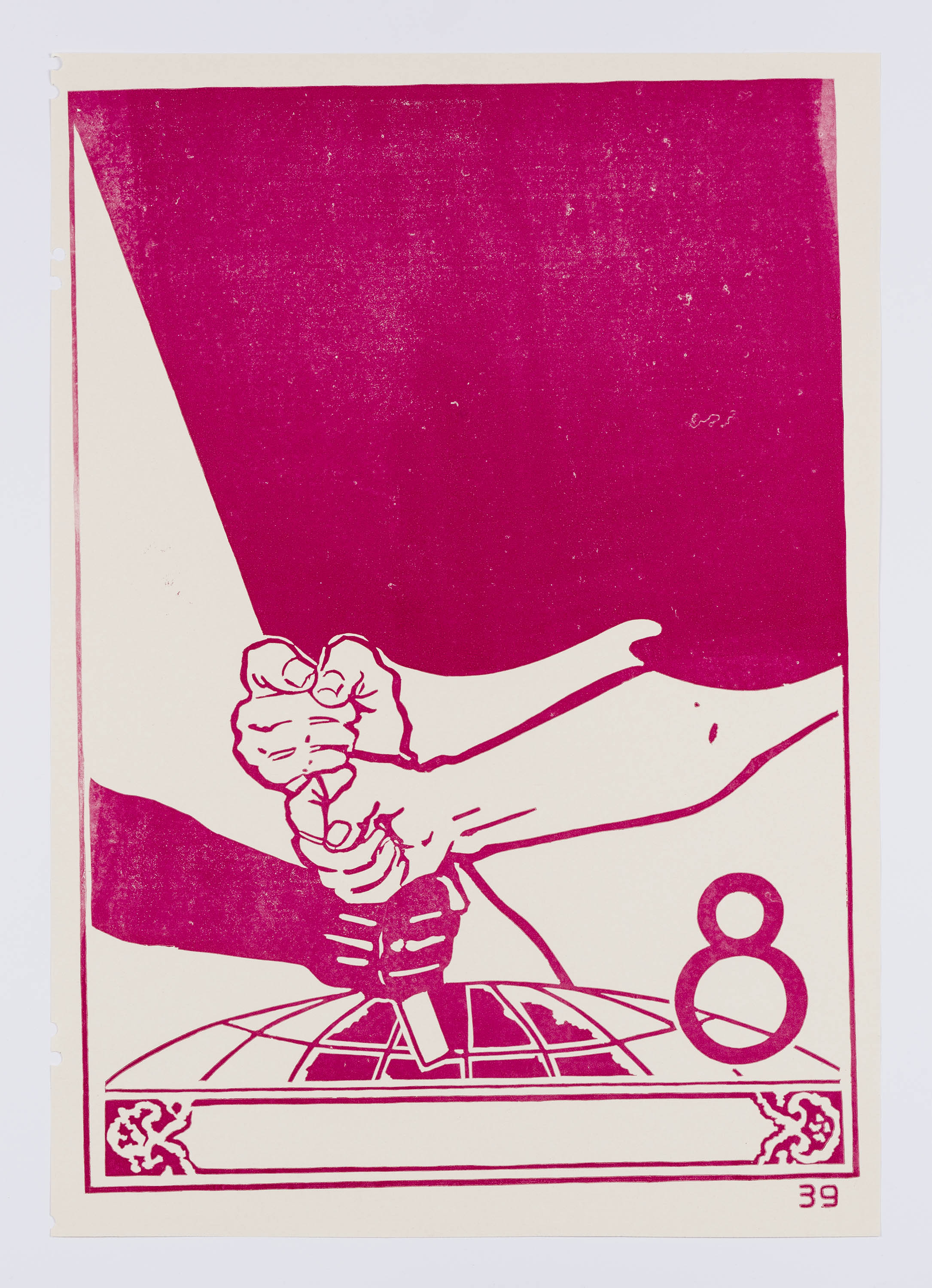
KP Brehmer
GIVE,1967
Cliché print on paper
19 ⅝× 13 ¾ inches (49.85 × 34.93 cm)
Outside of the regular edition of 70 (René Block, B 99)
“At the beginning of 1966, I produced my first stamp in an oversize format, the well-known Hitler stamp, which first flooded Germany during the 1000-year Reich and later half of Europe. From this stamp, I developed a motif chain of about 50 sheets. The deliberate choice of motifs is not limited only to adopting existing stamps, but some motifs were simplified, made more explicit, and others were substantially changed by montage. In this process, the content was joined by a formal process. I wanted to relate the collector of fine art rather directly to the trivial world. I wanted to depict print collection as an especially perverted form of art consumerism. So I developed complicated variations of prints, with different print runs, stamped or unstamped, off colors, etc., things equally appealing to the stamp collector and the print collector. Seen in this way, the action is a kind of contribution to the sociology of art, and I hope the consumer of art will thus come to reflect on his situation in a salutary way.” KP Brehmer

KP Brehmer
Welt im Kopf [World in Mind] – Skala [Scale], 1970
16 mm film, color, 8 min
Dieser Film zeigt die Veränderung eines Materials. Gewidmet den Firmen Schering und Bayer. [This film shows the transformation of a material. Dedicated to the companies Schering and Bayer.]
Since the mid-1960s, KP Brehmer has produced more than thirty conceptual short films that can be associated with Structural film, Performance Art, and Fluxus and preceded or expanded his physical artworks. Welt im Kopf [World in Mind], a 16 mm film from 1970, addresses different meanings of color and relates to what the artist has described as increasing an “awareness of color.” The film’s dedication to the chemical and pharmaceutical giants Schering and Bayer hints at the companies’ role in the Nazi war machine and later as producers of the herbicide Agent Orange used for chemical warfare in Vietnam.
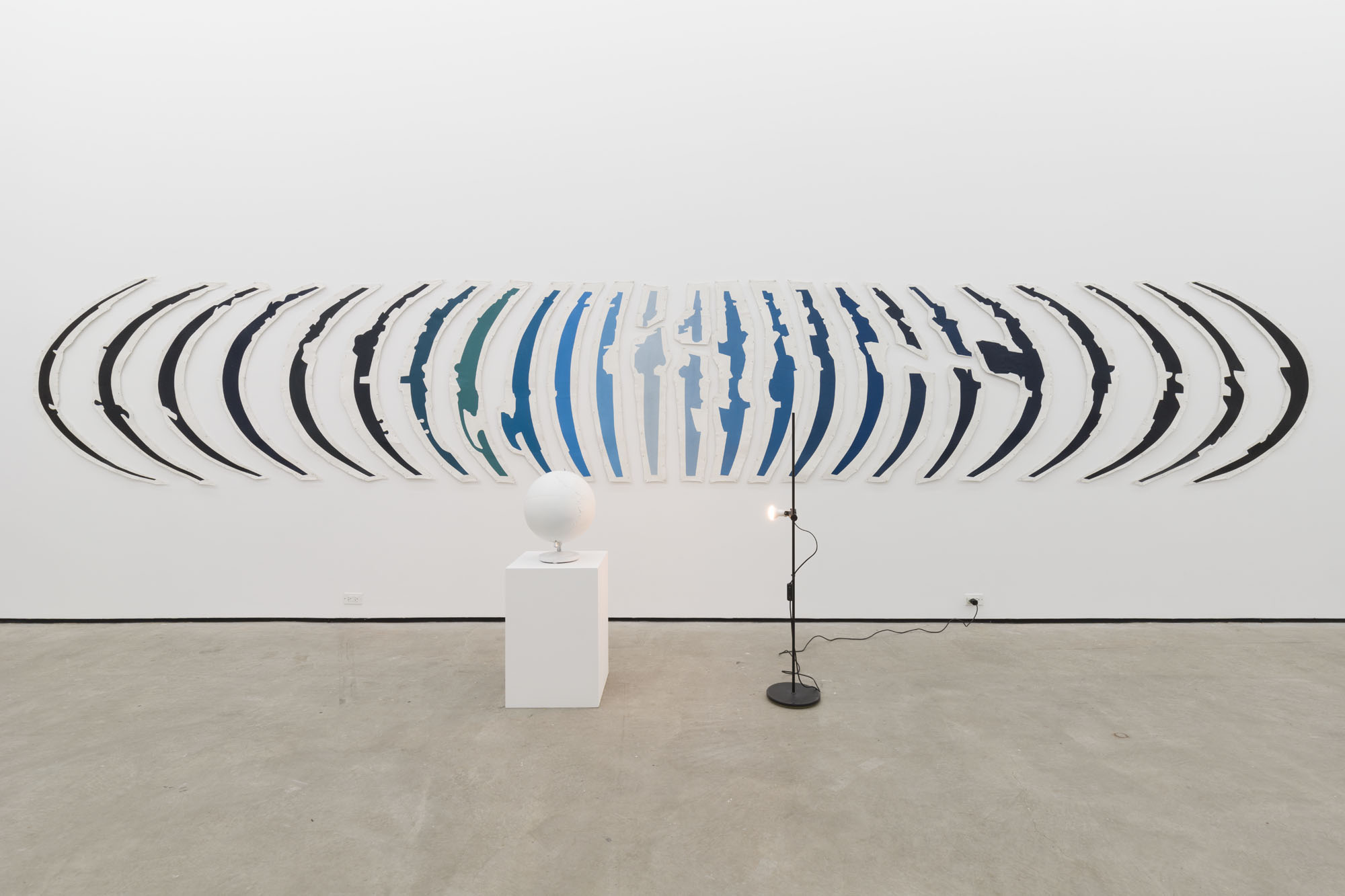
KP Brehmer
Zeitzonen [Time zones], 1975/76
Acrylic on PVC, floor lamp, plastic globe
Dimensions variable
Unique
From 1974 to 1977, René Block—who exhibited Brehmer extensively in his Berlin gallery in exhibitions such as Neodada, Pop, Décollage, and Kapitalistischer Realismus—ran a gallery at 409 West Broadway in New York City’s SoHo district. In New York, Block organized exhibitions and actions such as Joseph Beuys’s I like America and America Likes Me, group exhibitions and two solo exhibitions by KP Brehmer: Pictures at an Exhibition in 1975 and Time in 1976, each consisting of a newly conceptualized installation that occupied the entire gallery. The latter of Brehmer’s exhibitions were part of the series “Made.” Running from April to June that year, this project included solo presentations by Rebecca Horn and K. H. Hödicke and was accompanied by an eponymous publication.
Zeitzonen (which was first shown under the title Time zones because Brehmer usually translated titles of exhibitions and works into the local language) fuses several interests in Brehmer’s work that can be described as “diagrammatic practice” (Doreen Mende). That is the ability of a “static” picture to display change, the fundamental abstraction of time, and the meaning of color vis-à-vis the functioning of the map as a visual communication device in establishing and maintaining a hegemonic grasp on reality. In the installation, the two-dimensional world map is respatialized into time zones—single canvases with assigned shades of blue—and juxtaposed with the abstracted sphere of a white globe. Centered on London, the historical capital of the globe-spanning colonial British Empire, it unveils itself to be a highly distorted geometric projection. Here, both the world map and the unified system of time zones form a hegemonic system of spatial and temporal unification, instrumental to colonial and imperial expansion and globalization. For instance, Franco changed Spain’s time zone in 1949, so clocks in Madrid ticked in step with Hitler’s Berlin and Mussolini’s Rome.
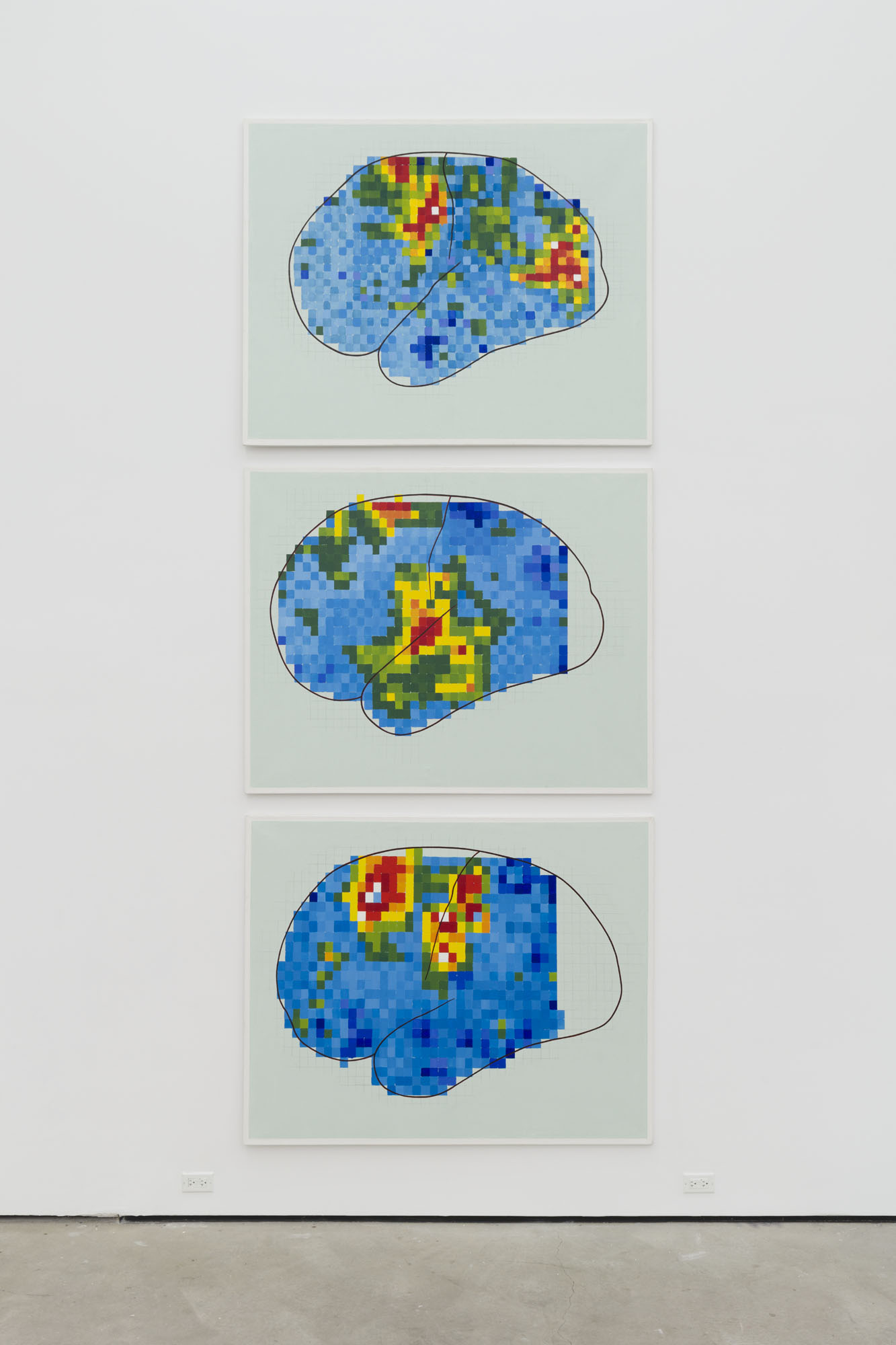
KP Brehmer
Über die Bilder – Bilder Ansehen [About the Images – Viewing Images], 1979
Emulsion paint on canvas
3 parts, each 47 ¼ × 59 inches (120.02 × 149.86 cm)
Unique
Dreiteilige Versionen, ausgehend von Durchblutungsmustern der Großhirnrinde nach Lassen, Ingvar, and Skinhøy [3 part versions, based on blood flow patterns of the cerebral cortex according to Lassen, Ingvar, and Skinhøy]
No. 1 Bilder Ansehen [No. 1 Viewing Images]
No. 2 Über Bilder Reden [No. 2 Talking About Images]
No. 3 Mit Händen und Füssen Reden [No. 3 Talking with One’s Hand]
“Extension of representational properties in painting. First heat paintings since 1973. As a new dimension, heat is included in the painting. All bodies radiate heat in the form of invisible infrared radiation. It can be caught with infrared devices and converted into visible images. This is done using high-sensitivity detectors, which convert the thermal radiation into electrical signals, which are then amplified and displayed on a screen. These images are the ‘model’ for my paintings. Thermal images look alienated compared to conventional photographs. Warm persons and objects appear bright, less warm ones dark.” KP Brehmer
From the mid-1970s to the late1980s, Brehmer made figurative works on canvas or paper by pouring or painting emulsion or watercolor. These works are based on thermal images from medical diagnostics published in the German popular magazine Stern. Rather than marking a shift to painting in Brehmer’s practice, the subject of these works is still how “trivial” technical images shape the individual and collective perception of reality. Brehmer makes this clear when adding below an earlier painting from this series: “This is not a modern painting, but a ‘heat photograph.’” Here, Brehmer returns to a core approach in his practice, which is forcing his artworks into parallel processes that regard the development of both artistic and technological image-making amidst the backdrop of wider societal change (a new wave of lifestyle consumerism and the emergence of a neoliberal order) that trumpets an ideology of individualism. When rendering the appropriated thermal images by brush, he comments on the return of painterly subjectivity—the figure of the singular author depicting the world around them, like the artists in the German neo-expressionist movement Neue Wilde—against the relentless advancement of the gaze of the apparatus, which penetrates, quantifies, and qualifies the innermost emotions, as well as bodily and mental states.
This work is based on studies by Lassen, Ingvar, and Skinhøy of blood-flow patterns in the cerebral cortex during different activities such as viewing, speaking, and gesturing about images—immaterial labor performed in the context of galleries, museums, and artists’ studios. The resulting activity in different regions of the brain is depicted by color, which is applied two-dimensionally with a brush, leaving the screen-printed scientific template recognizable.

KP Brehmer
Seele und Gefühle eines Arbeiters (Soul and Feeling of a Worker), c. 1974
Ink on paper
12 parts, each 8 ¼ × 11 ⅝ inches (20.96 × 29.53 cm)
Unique
In 1932, Rexford B. Hersey published an early work of industrial and organizational psychology on the relationship between the emotional states and productivity of Pennsylvania Railroad workers, titled Workers’ Emotions in Shop and Home: A Study of Individual Workers From the Psychological and Physiological Standpoint. Shortly after, and around the time of the Nazi takeover of the German government, Hersey was invited to Germany by a German-American industrialist trust. Hersey surveyed German railway workers in Berlin and other places by questioning them individually at least four times daily. This study was published in 1935 in German as Seele und Gefühl des Arbeiters: Psychologie der Menschenführung [Soul and feeling of the worker: psychology of human management] with a foreword by prominent Nazi politician and labor union leader Robert Ley. Brehmer, whose father worked for the German railway during the time of Hersey’s studies, first showed Seele und Gefühle eines Arbeiters in the 1978 exhibition Thirteen Degrees East: Eleven Artists Working in Berlin at Whitechapel Gallery in London. Coincidentally, during the same year in Paris, Michel Foucault analyzed how power in modern nation-states is encoded into social practices and human behavior, promoting self-regulation as what was later coined “biopolitics.”
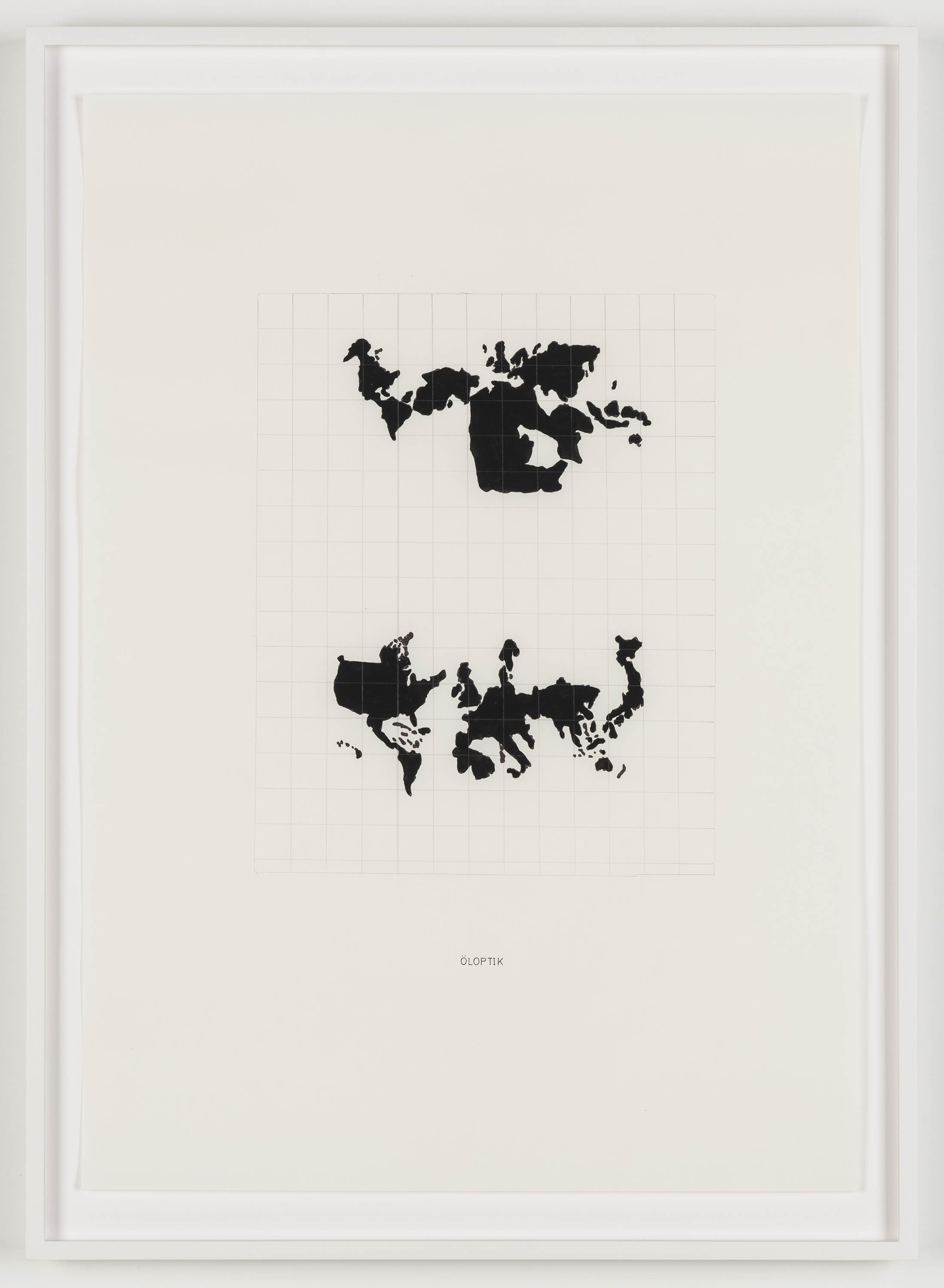
KP Brehmer
Öloptik [Oil optics], undated
Dispersion, pencil on paper
23 ½ × 16 ½ inches (59.69 × 41.91 cm)
Framed: 26 ⅛ × 19 inches (66.36 × 48.26 cm)
Unique
Upper: Oil Production
Lower: Oil Consumption
Amidst global economic turmoils of the 1970s, such as the Oil-Crisis, recessions, and increasing pressures on the Western welfare states, Brehmer produced a series of works that are based on diagrams and charts and follow a central artistic strategy of his: that the best way to comment on societal and economic conditions is to present their presentation. These motifs are taken from widely available publications and reports that describe the world around him through data on a wide range of issues such as commodity prices, wealth distribution –for instance between the black and white population in the US– global population growth, census of employment and wages, and public spending and debt.
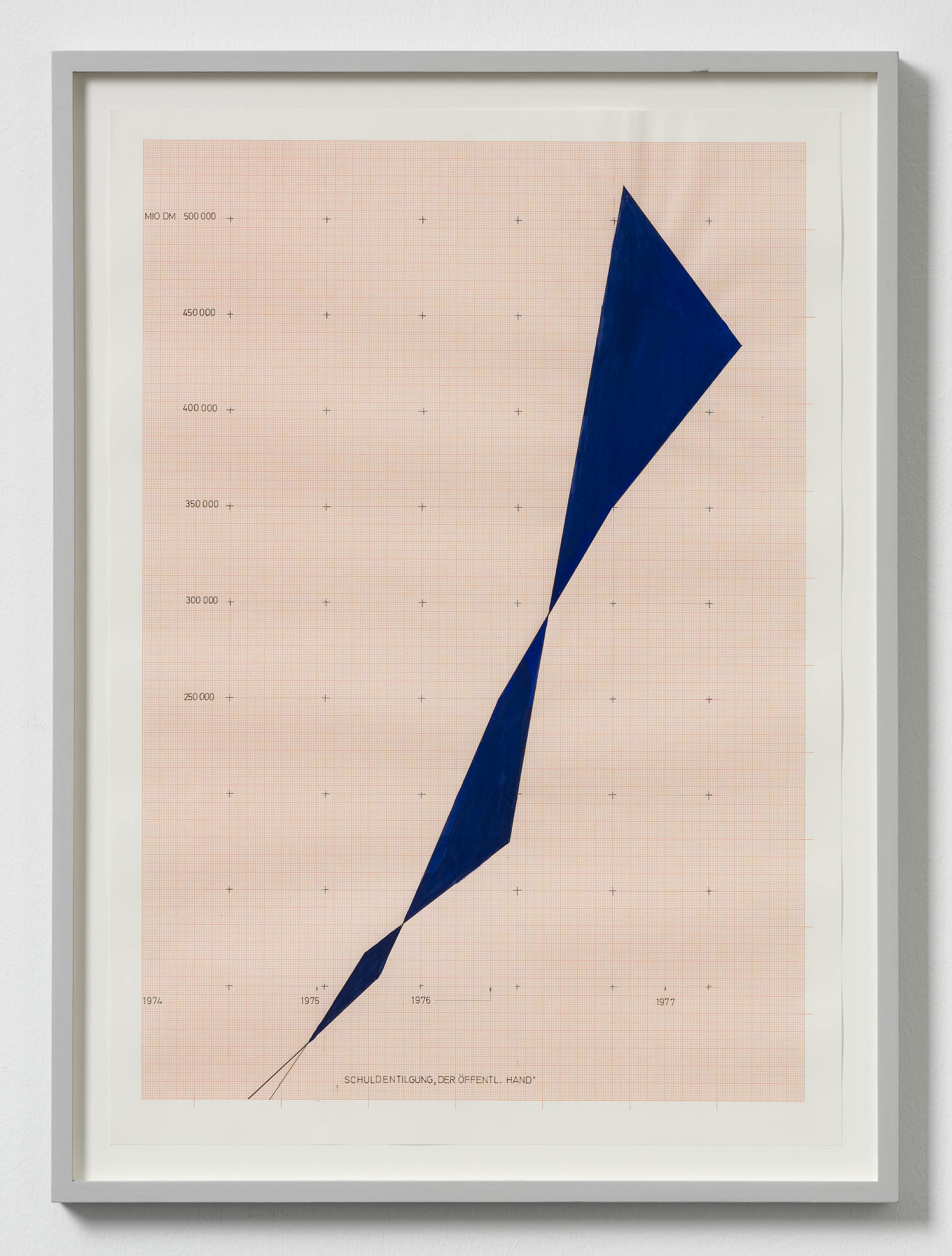
KP Brehmer
Schuldentgiltung der öffentl. Han [Repayment of public-sector debt], 1970
Watercolour and pencil on graph paper
59.4 × 42 cm (23 ⅜ × 16 ½ inches)
Framed: 66.5 × 48.5 × 3.5 cm (26 ⅛ × 19 ⅛ × 1 ⅜ inches)
Unique
Vertical Axis: MIO DM [Million Deutsche Mark]
Horizontal Axis: Date
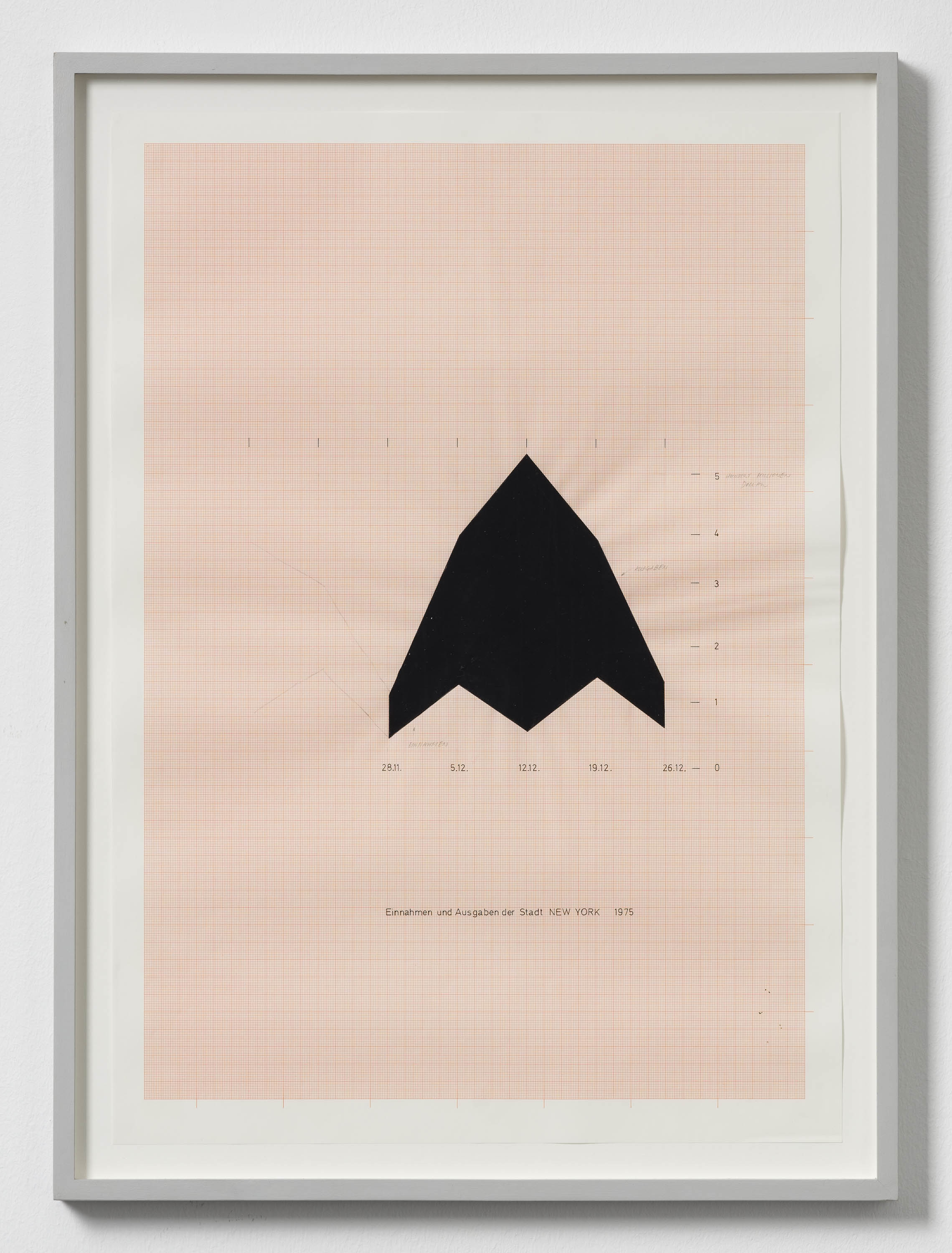
KP Brehmer
Einnahmen und Ausgaben der Stadt New York 1975 [Revenues and Expenditures of the City of New York 1975], 1976
Watercolour and pencil on graph paper
23 ⅜ × 16 ½ inches (59.37 × 41.91 cm)
Unique
Vertical Axis: Hundert Millionen Dollar [Hundred Million Dollar]
Horizontal Axis: Date
Top Line: Ausgaben [Expenditure]
Bottom Line: Einnahmen [Revenue]
This work, presumably prompted by his travels to New York and the broader media attention the city’s impending bankruptcy was receiving, is based on a diagram depicting public revenues and expenditures. In responding to the city’s fiscal crisis for the first time, new and neoliberal economic thinking was implemented in the US, and banks leveraged unprecedented demands: up-to-the-day financial data on city expenses—information the city wasn’t able to provide.
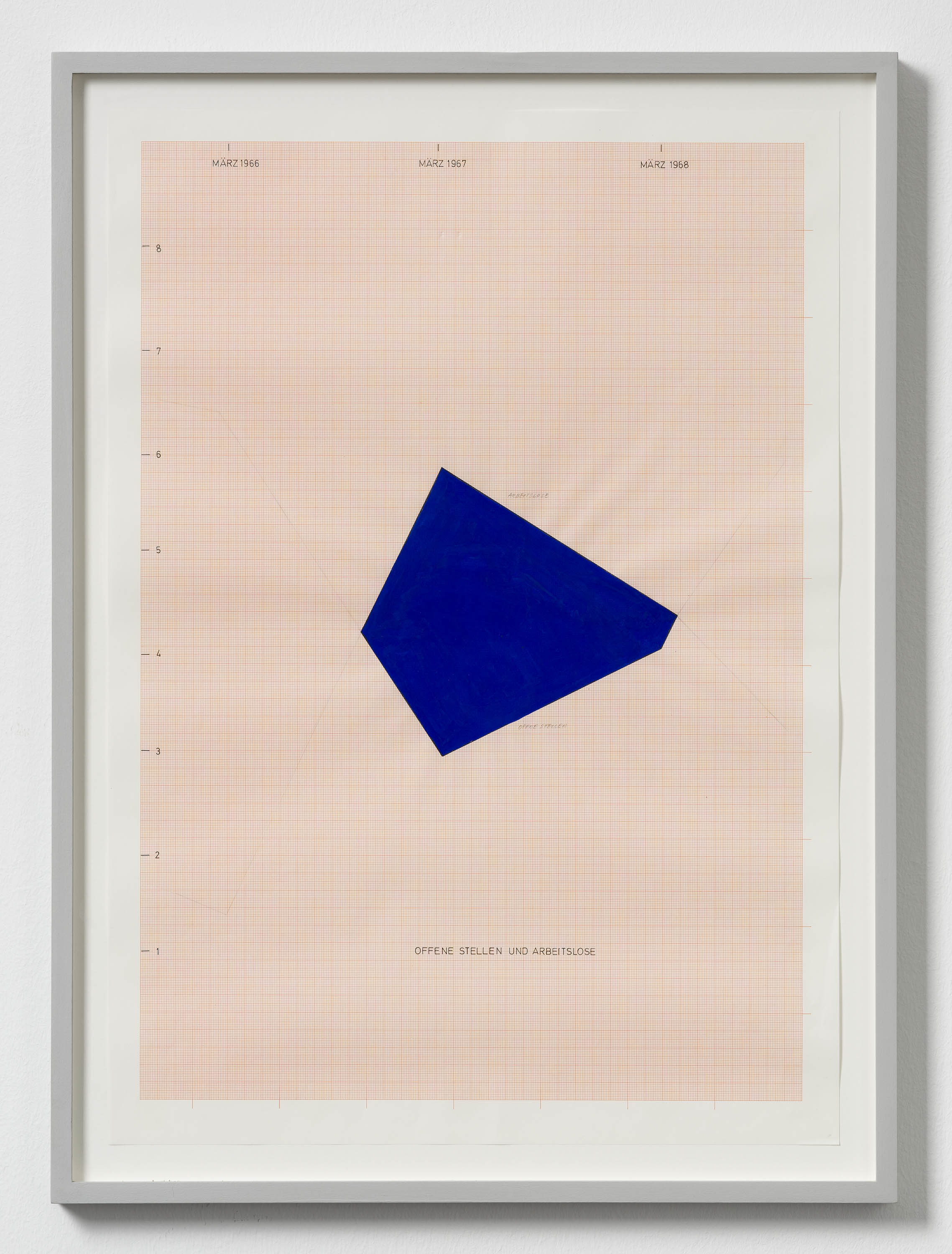
KP Brehmer
Offene Stellen und Arbeitslose [Job Vacancies and unemployed], 1976
Watercolour and pencil on graph paper
16 ½ × 23 ½ inches (41.91 × 59.69 cm)
Unique
Vertical Axis: Million
Horizontal Axis: Date
Top Line: Arbeitslose [Unemployed]
Bottom Line: Offene Stellen [Job Vacancies]
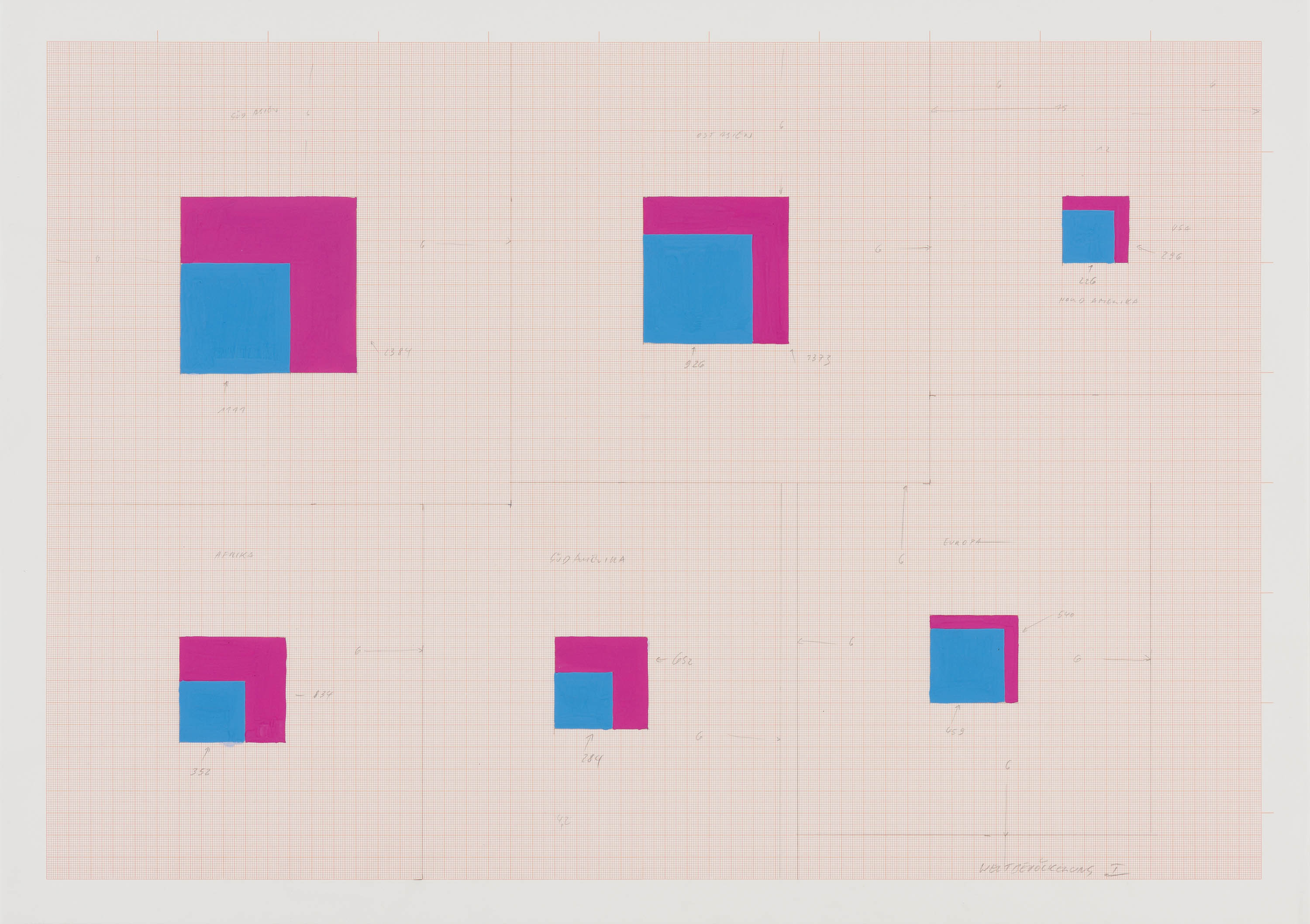
KP Brehmer
Weltbevölkerung I [World population I], undated
Emulsion paint, pencil on graph paper
16 ½ × 23 ½ inches (41.91 × 59.69 cm)
Unique
Süd Asien [South Asia], Ost Asien [East Asia], Nord Amerika [North America]
Afrika [Africa], Süd America [South America], Europa [Europe]
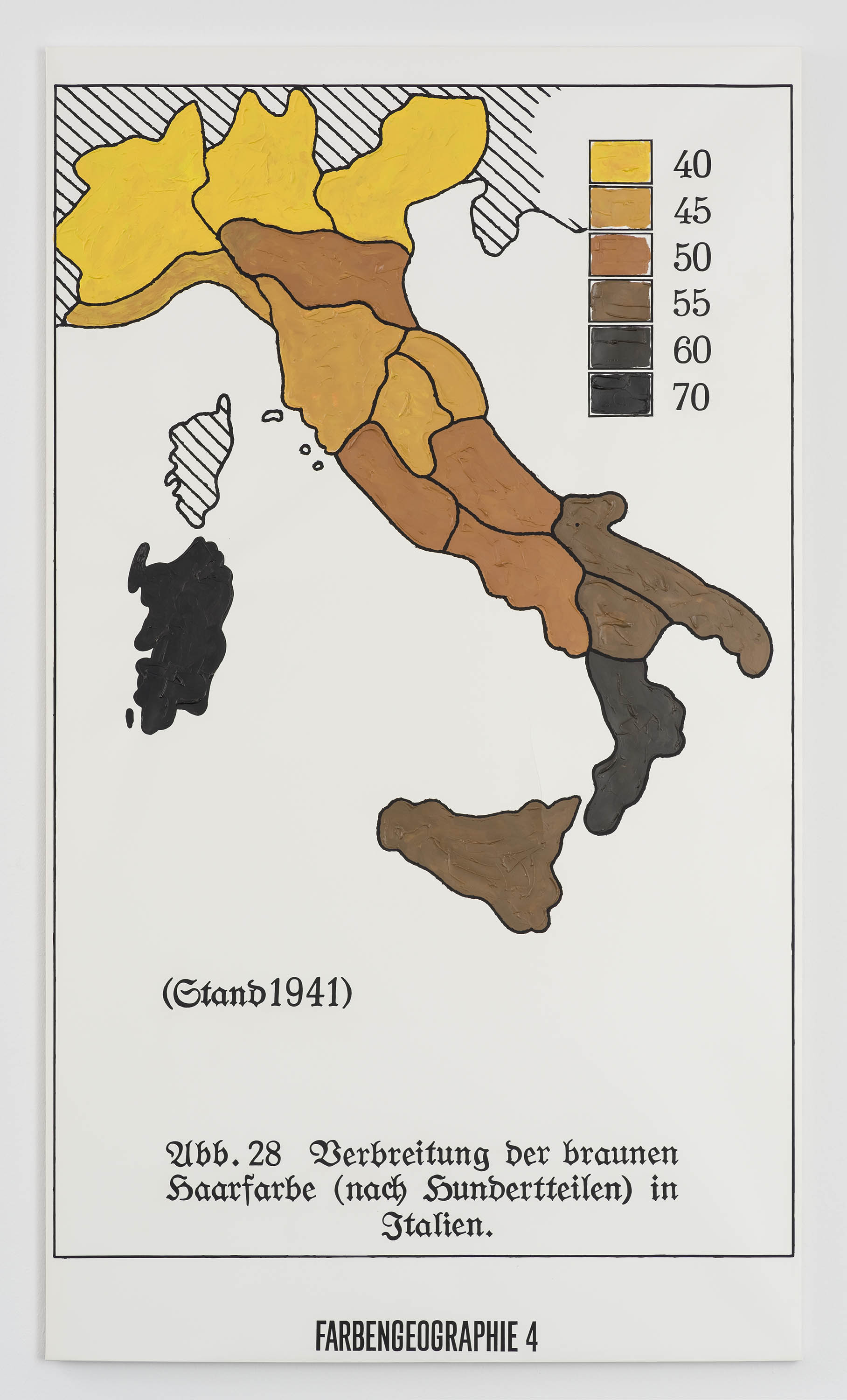
KP Brehmer
Farbengeographie [Color geography] Nr. 4, 1972
78 ¾ × 45 ¼ inches (200.03 × 114.94 cm)
Unique
Abbildung 28. Verbreitung der braunen Haarfarbe (nach Hundertteilen) In Italien [Figure 28. distribution of the brown hair color (by hundred parts) in Italy]
“From a school book for general education in 1943. Distribution of brown hair in Italy. Italy had already been ruled by the Fascists for twenty years when the book was published.” “Farbengeographie [Color Geography] is an effort to contribute to the expansion of the awareness of color. Color symbols (codes) are made ‘tangible’ by means of localization.” KP Brehmer